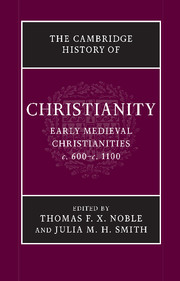Book contents
- Frontmatter
- Introduction: Christendom, c. 600
- Part I Foundations: Peoples, Places, and Traditions
- Part II Christianity in Confrontation
- 7 Christians and Jews
- 8 The Mediterranean Frontier: Christianity face to face with Islam, 600–1050
- 9 Christians under Muslim rule
- 10 Latin and Greek Christians
- 11 The northern frontier: Christianity face to face with paganism
- Part III Christianity in the Social and Political Order
- Part IV Christianity as Lived Experience
- Part V Christianity: Books and Ideas
- Conclusion: Christendom, c. 1100
- Bibliographies
- Index
- References
10 - Latin and Greek Christians
from Part II - Christianity in Confrontation
Published online by Cambridge University Press: 28 March 2010
- Frontmatter
- Introduction: Christendom, c. 600
- Part I Foundations: Peoples, Places, and Traditions
- Part II Christianity in Confrontation
- 7 Christians and Jews
- 8 The Mediterranean Frontier: Christianity face to face with Islam, 600–1050
- 9 Christians under Muslim rule
- 10 Latin and Greek Christians
- 11 The northern frontier: Christianity face to face with paganism
- Part III Christianity in the Social and Political Order
- Part IV Christianity as Lived Experience
- Part V Christianity: Books and Ideas
- Conclusion: Christendom, c. 1100
- Bibliographies
- Index
- References
Summary
At the end of Late Antiquity, when this chapter begins, the Alps were a Great Divide between Mediterranean cultures and transalpine ones; Rome and Constantinople had more in common with one another than either did with Germanic groups in the north. The emperors in Constantinople still wielded enough authority in Rome to arrest popes who resisted their policies, and the papal apokrisiarios at the imperial court was an important figure in Rome. But by 1100 the popes themselves often came from north of the Alps, few in the West knew Greek, and imperial authority, when acknowledged in Rome, came from Germany. The Latin world, developing with, assimilated to, and combined with the Germanic world of northwestern Europe, had lost sympathy for imperial and Byzantine ways of ruling while developing its own hierarchies. The role and prestige of the popes in the western church was beyond the ken of Byzantines, while the role of the emperor in the eastern church puzzled and appalled Latin Christians. Theological and ritual differences added to a general sense of estrangement, reflected most famously in chronicles of the crusades. To describe relations between Greek and Latin Christians between the seventh century and the eleventh is, then, to write the history of the schism between the Roman Catholic and Greek Orthodox churches. Yet overabundant hindsight lurks in such a statement. A narrative which begins at the end – with schism – tends to overemphasize disagreements in earlier eras and to overlook charity and cooperation. It tends to rely on sources that “explain” the origins of the schism and to overlook sources that assume or explicitly say that there was no schism at all.
- Type
- Chapter
- Information
- The Cambridge History of Christianity , pp. 213 - 229Publisher: Cambridge University PressPrint publication year: 2008
References
- 4
- Cited by



